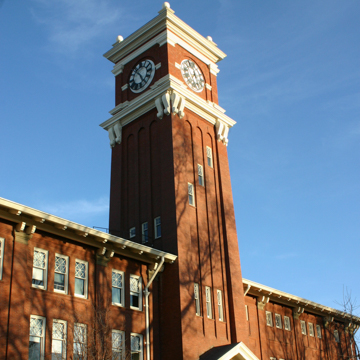You are here
Bryan Hall
The grand sentinel of the Palouse Country for more than 100 years, Bryan Hall and its clock tower are perhaps the university’s most immediately recognizable features. Situated near the apex of the college’s main hill and helping to form the eastern side of what amounted to a large quadrangle-like expanse, the red brick building marked the conclusion of an initial period of construction on the young campus; its tower symbolically marking the college’s arrival—and permanence—in the region.
The hall, originally called the Library-Auditorium Building, was named for Enoch A. Bryan, the college’s third president (1893–1916)—perhaps the single-most important force behind the college’s desire to establish itself academically as well as architecturally. Indeed, it was during Bryan’s administration that the campus expanded from the small, unornamented building known as the “Crib,” which accommodated 59 students and 5 faculty members, to some 12 substantially built, red brick structures for approximately 20 departments, 140 faculty members, and more than 1,500 students. Bryan Hall, completed in 1909 and dedicated in Bryan’s honor in May 1916, put a symbolic, if not literal, exclamation point on the initial era of design and construction at the college.
It is not clear that there was ever intention on the part of college administrators, the Board of Regents, or the architect to make Bryan Hall a new campus symbol to compete with the Administration Building (Thompson Hall) to its east, although it stood at a higher elevation and its clocktower made it the tallest building on campus. Instead, the focus of construction centered on Bryan Hall’s multipurpose function: it was built to serve as a permanent location for the college library and as the campus assembly hall or auditorium. The two-tiered, 778-seat assembly hall, which occupies the southern half of the building, remains mostly intact, although the original wooden benches were replaced with wooden seats in the 1950s. The books and manuscripts of the library, meanwhile, filled the northern half of the building. The library space was later subdivided for office and instructional use once its collections were transferred to the new Holland Library in 1950.
Spokane-based architect J.K. Dow designed Bryan Hall on a site sloping from east to west. The $130,000 structure is mostly symmetrical, with the clock tower bisecting the building that, due to the slope, features three stories along its west-facing side but only two on the east. Exterior features include variegated patterns of brick and wood delineating features from several historical periods of the architectural canon, many of which could be affiliated with the classical tradition. This includes two-story, brick Doric pilasters with bases and capitals of sandstone on all sides; stretched blind Romanesque arches articulating the tower shaft; wooden Ionic scrolls below the clock ensemble; and several carved wooden brackets supporting the roof cornice. Thin, cascading windows in patterns of three on the west and south sides of the tower shaft suggest the internal staircase that leads up to the clock, and wooden entrance porticos on both the west and east sides feature raking cornices and deep pediments extending from the brick facing.
The building appears to have no direct design precedent in the history of architecture, although by 1909 campaniles and clock towers had been erected for several universities around the United States, many of which bore general resemblance to the Giraldo Tower in Seville, Spain, which itself looked to the St. Mark’s Tower in Venice, Italy. In terms of combining principal college functions into one building that included a clock tower, it is possible that Bryan himself admired Harvard University’s more elaborate Memorial Hall [MA-01-NY1], which featured an art gallery and an auditorium—a university from which he had received a master’s degree in classical studies in 1893 just prior to assuming the helm as the president of the new state college in Washington.
Much of Bryan Hall’s interior was remodeled from 1972 to 1973 by James and Hicks architects of Spokane. This renovation included the remodeling of the main hallway with new light fixtures and a grand, new wooden doorway attached to the original interior entryway to the auditorium. Although the low-relief stylized figures and objects on the wooden doorway, seemingly arranged after the fashion of the Standard of Ur, might suggest that the door was carved with the original structure, the door panels were purchased from the “Forms and Surfaces” pattern series as part of the 1972 renovation and affixed to black laminated plastic.
Today, the auditorium is operated by the School of Music, which hosts regular performances and recitals. The northern half of the building includes the offices for the university’s International Programs on the first floor and the Thomas S. Foley Institute for Public Policy and Public Service, established in 1995, on the second. Large windows facing Holland Library on the eastern facade mark the location of a large, high-ceilinged classroom that once housed much of the library collection. Chimes were installed in the clock tower in the mid-1940s, and the clock faces, originally lit in 1946, were replaced in 2010. The clock provides a red glow at night that is visible for miles around.
Writing Credits
If SAH Archipedia has been useful to you, please consider supporting it.
SAH Archipedia tells the story of the United States through its buildings, landscapes, and cities. This freely available resource empowers the public with authoritative knowledge that deepens their understanding and appreciation of the built environment. But the Society of Architectural Historians, which created SAH Archipedia with University of Virginia Press, needs your support to maintain the high-caliber research, writing, photography, cartography, editing, design, and programming that make SAH Archipedia a trusted online resource available to all who value the history of place, heritage tourism, and learning.





















